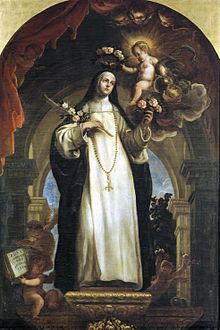
Back Santa Rosa de Lima AN روزا من ليما Arabic Rosa de Lima AST Rosa de Lima Aymara Роза Лімская Byelorussian Сьвятая Роза Лімская BE-X-OLD Rosa Lima Breton Rosa de Lima Catalan Rosa sa Lima CEB Růžena Limská Czech
Saint Rose of Lima | |
|---|---|
 | |
| Virgin | |
| Born | Isabel Flores de Oliva April 20, 1586[1] Lima, Viceroyalty of Peru |
| Died | August 24, 1617 (aged 31)[1] Lima, Viceroyalty of Peru |
| Venerated in | Catholic Church |
| Beatified | April 15, 1667 or 1668, Rome, Papal States by Pope Clement IX |
| Canonized | April 12, 1671, Rome, Papal States by Pope Clement X[1] |
| Major shrine | Basilica of Santo Domingo Lima, Peru |
| Feast | August 23 August 30 (some Latin American countries and pre-1970 General Roman Calendar) |
| Attributes | Dominican tertiaries' habit, roses, anchor, Infant Jesus |
| Patronage | embroiderers; sewing lace; gardeners; florists; people ridiculed or misunderstood for their piety; for the resolution of family quarrels; against vanity; indigenous peoples of the Americas; Latin America; Peru; Philippines; the Indies;[2] Villareal; Santa Rosa, California; Santa Rosa, Laguna; Santa Rosa, Nueva Ecija; Alcoy, Cebu; Daanbantayan, Cebu; Arima, Trinidad and Tobago;[3] Lima; Sittard |
Rose of Lima, TOSD (born Isabel Flores de Oliva; 20 April 1586 – 24 August 1617) was a member of the Third Order of Saint Dominic in Lima, Peru, who became known for both her life of severe penance[4] and her care of the poverty stricken of the city through her own private efforts. Rose of Lima was born to a noble family and is the patron saint of embroidery, gardening and cultivation of blooming flowers. A lay member of the Dominican Order, she was declared a saint by the Catholic Church, being the first person born in the Americas to be canonized as such.[1]
As a saint, Rose of Lima has been designated as a co-patroness of the Philippines along with Pudentiana; both saints were moved to second-class patronage in September 1942 by Pope Pius XII, but Rose remains the primary patroness of Peru and of the local people of Latin America. Her image is featured on the highest denomination banknote of Peru.
- ^ a b c d Marques, Luis Carlos L. (2000). "Rose de Lima". In Leonardi, C.; Riccardi, A.; Zarri, G. (eds.). Diccionario de los santos (in Spanish). Vol. II. Madrid, Spain: San Pablo. pp. 2003–2006. ISBN 84-285-2259-6.
- ^ Cite error: The named reference
SacrosanctiApostolatusCurawas invoked but never defined (see the help page). - ^ "Home".
- ^ Cite error: The named reference
aymewas invoked but never defined (see the help page).
© MMXXIII Rich X Search. We shall prevail. All rights reserved. Rich X Search